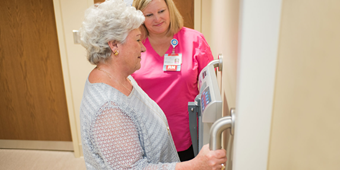Killer Cramps or Something More?

Answer a few questions and we'll provide you with a list of primary care providers that best fit your needs.
If you’re a woman past the age of puberty, odds are that you’ve experienced some menstrual cramping during your period. Most of us accept it as a fact of life, but for some women, it may signal endometriosis.
If you have endometriosis, the tissue that typically lines your uterus begins growing in other areas of your pelvis or beyond, often causing a range of symptoms from mild to severe.
What Are Symptoms of Endometriosis?
Women with endometriosis don’t always have symptoms, but inflammation and bleeding of the abnormally growing endometrial tissue can lead to pain and discomfort. Some common signs to watch for include:
- Severe menstrual cramps or heavy menstrual cycles
- Long-term pain in your lower back and pelvis
- Pain before or during your menstrual period
- Pain during or after sex, usually described as “deep” pain that’s not at the entrance of the vagina
- Intestinal discomfort
- Painful bowel movements or urination during your menstrual cycle
- Bleeding or spotting between periods
- Fatigue
- Stomach and digestive problems, including diarrhea, constipation, bloating or nausea, especially during menstrual periods
- Trouble getting pregnant. Endometriosis greatly reduces fertility and occurs in up to 50 percent of infertile women. However, not all women who have endometriosis are infertile.
After menopause, some women feel less pain, but this is not always true. If you take hormones or medicines to reduce menopausal symptoms, you may continue to have symptoms of endometriosis.
Heather Hilkowitz, MD, Hilltop Obstetrics & Gynecology, describes the symptoms of endometriosis.
Click play to watch the video or read video transcript.
How Do You Diagnose Endometriosis?
Your physician or healthcare provider will listen to your history of symptoms and perform a pelvic exam as the first step in checking you for endometriosis. These may give her with a good idea about whether you have the condition, but they won’t provide proof of the diagnosis.
If you are having symptoms, a laparoscopy offers the best way to diagnose endometriosis. In this outpatient procedure, a tiny camera is inserted into your abdomen through a small incision. The camera takes pictures of the surface of your uterus, fallopian tubes, ovaries and other pelvic organs. If necessary, your doctor can remove a small sample of tissue, called a biopsy, for further study.
Women with endometriosis don’t always have symptoms.
Ultrasound or other imaging tests cannot confirm the condition. But they can be useful in identifying cysts or other causes of pelvic pain or infertility.
Dr. Hilkowitz talks about diagnosing endometriosis.
Click play to watch the video or read video transcript.
How Serious Is Your Endometriosis?
Doctors classify endometriosis as minimal, mild, moderate or severe. Most women have minimal or mild endometriosis. The stage depends on factors such as:
- Number, size, and site of endometrial tissue implants
- Presence and extent of adhesions (scar tissue)
- Involvement of other pelvic organs
The stage may not match the pain you feel. Even early stages can cause a lot of pain.
Having a diagnosis will allow you to take action in resolving your symptoms.
Learn more about medical therapies and surgical options for endometriosis.
Answer a few questions and we'll provide you with a list of primary care providers that best fit your needs.
Source: American Congress of Obstetricians and Gynecologists; WomensHealth.gov; National Institutes of Health; American Society for Reproductive Medicine; Heather Hilkowitz, MD, Hilltop Obstetrics & Gynecology







